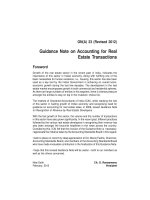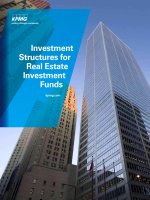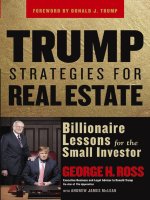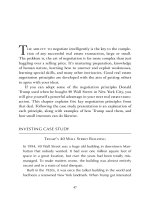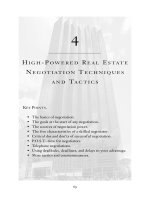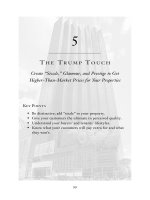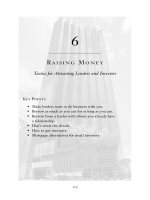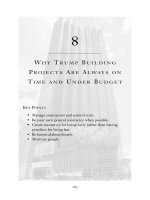TRUMP STRATEGIES FOR REAL ESTATE CHAPTER 6 pps
Bạn đang xem bản rút gọn của tài liệu. Xem và tải ngay bản đầy đủ của tài liệu tại đây (978.62 KB, 28 trang )
125
6
R
AISING
M
ONEY
Tactics for Attracting Lenders and Investors
K
EY
P
OINTS
•Make lenders want to do business with you.
•Borrow as much as you can for as long as you can.
•Borrow from a lender with whom you already have
a relationship.
•Don’t sweat the details.
•How to get investors.
•Mortgage alternatives for small investors.
127
R
AISING MONEY
,
WHETHER
it’s derived from investors, family,
friends, or borrowed from commercial lenders, is one of the
most crucial elements in any real estate transaction. The use of bor-
rowed money to buy real estate serves several purposes: It gives you
more leverage, which enables you to purchase much more, often 20
or 30 times more than what could otherwise be bought for cash; it
reduces your equity exposure; and the interest payments on the loan
provide a significant tax deduction.
When Trump invests in a real estate project, he typically puts up
less of his own money than you might think. For example, he will
often erect a building to either rent out the available space or sell the
residential units in it. Typically, his investors in the project will put
up 85 percent while Trump puts up 15 percent. Then he and his part-
ners get a fixed rate of return on their cash investments. However, the
return accrues and is not paid until there are cash proceeds to distrib-
ute. When units are sold, Trump uses the excess funds over and above
themortgage to be applied to the accrued interest. When the accrued
interest has been paid, available funds are used to repay the cash in-
vestment of the partners. When all partners get back all their money
plus the accrued interest, additional proceeds are divided among the
partners. But the split of the excess funds is no longer 85 percent for
thepartners and 15 percent for Trump. Now the split of the profits
couldbe50–50, 40–60, or 25–75, depending on certain variables in-
herent in the transaction. It depends on the interest rate paid to the
outside partners. The higher the rateofinteresttheoutside partners
get, the lower the percentage they get. The lower the rate of interest
paid to the outside partners, the higher the percentage they get. Keep
TRUMP STRATEGIES FOR REAL ESTATE
128
in mind thehuge size of Trump projects, and that relatively speaking,
15 percent is a big number. If we’re talking about building a $300 mil-
lion building, then 15 percent represents $45 million.
Tr ump often has some group or large company participating as a
partner. It may be a huge corporation such as General Motors (GM)
or General Electric (GE). With partners such as these, Trump can get
a very favorable large loan well below the prime rate and often without
the need for a mortgage and payment of the recording taxes involved.
Without these types of partners, Trump could never get that kind of a
loan. When GM borrows from a bank, they get a low rate based on
their credit, so Trump likes to work with these kinds of partners.
Working with monied outside investors enables him to participate
in many transactions without a monster exposure of dollars in a par-
ticular development. The Trump Organization furnishes the time, the
effort, the expertise, the staff, and the management for the entire
project. The sole function of the outside investors is financial.
Small investors can and should use a similar approach in financ-
ing their real estate investments. This chapter describes key princi-
ples for raising money from banks and investors, such as establishing
lender relationships, knowing how much to borrow, and knowing
methods of attracting investors. These are all instrumental to suc-
cessfully investing in real estate, regardless of the scale of your proj-
ect. By following Trump’s principles for real estate financing set
forth in this chapter, you can also avoid the costliest mistake many
investors make—using short-term money for long-term projects.
INVESTING CASE STUDY
T
HE
GM B
UILDING
The GM Building in New Yo rk City is massive. Built by General Mo-
tors as its headquarters, it’s a two-million square-foot 50-story struc-
R
AISING
M
ONEY
129
ture that fronts on 5th Avenue and Madison Avenue at the southeast
corner of Central Park in Manhattan. It is one of the few buildings in
the world that takes up an entire square block bounded by two major
avenues. It is regarded as the premier office building in New York
City.
When the property came up for sale in 1998 by a real estate in-
vestment trust, Trumpfelthehadtohaveit.However,oneofthe
majordrawbacks was a long-term lease of 400,000 square feet
with a major law firm ataverylowrentwithmanyoptionsforad-
ditional space as well as renewal terms. So, in effect, 20 percent of
the buildingwas frozen from future growth. That lease, together
with other long-term leases at below market rents, were key nega-
tive factors. On the positive side, the building was prestigious, had
agreat location, and the tenancy consisted of companies or indi-
viduals that were giants in the business world making the building
extremely attractive to major lenders who wanted the securityofa
stable rental stream.
The sales price of the GM Building was $800 million—all cash.
The challenge Trump faced was obtaining a huge mortgage loan at a
low interest rate, raising money for the balance of the purchase price,
and raising sufficient working capital since the existing cash flow was
anemic. The solution was finding a partner with deep pockets who
could be induced to participate in a massive undertaking.
Quite by accident, Trump met Steve Hilberg who was the CEO of
the Conseco insurance group, a public company loaded with money.
They became friends and Trump proposed a plan in which he and
Conseco would become partners, buy the GM Building, and make a
profit of $300 million within one year by turning the building into an
office condominium. Since major corporations had big blocks of
space, Trump believed that they would rather buy the space they oc-
cupied than face a major increase in rent when their respective
leases expired. Hilberg liked the concept especially since Donald
Tr ump, who was a superstar in New York City real estate, proposed
it.
TRUMP STRATEGIES FOR REAL ESTATE
130
GM Building
R
AISING
M
ONEY
131
They formed a joint venture in which Conseco agreed to put up the
bulk of the money over a new mortgage loan that Trump was able to
obtain.
Tr ump made a deal with Lehman Brothers that for a substantial fee
they would commit to fund $700 million at a low interest rate ac-
ceptable to Trump. This amount—$700 million—was almost 90 per-
cent of the purchase price—a very high loan to value ratio. Since the
loan was top heavy, Lehman required some guarantee to induce in-
stitutional investors to participate. Trump persuaded Conseco to give
the lenders the guarantee they wanted, to cover what the lenders
perceived to be excess loan proceeds. In order to achieve a low in-
terest rate, Lehman had to syndicate the loan (i.e., split the loan into
several pieces, each of which would have a different degree of risk
and a different interest rate, and would be sold to a different in-
vestor). The first mortgage loan of $500 million was layered in $100
million increments. The lender with the bottom layer would have the
highest priority of payment, but would receive the lowest rate of in-
terest. The lender with the top layer would have the lowest priority of
payment but the highest rate of interest.
For the remaining $200 million of proceeds, a secondary loan was
created that was subordinate to the primary loan of $500 million. In
a manner similar to the primary loan, the secondary was also layered
to cater to investors who had different appetites for risk and reward.
The secondary financing was coupled with the Conseco guarantee so
that it would carry a lower interest rate than one without a guaran-
tee. Conseco and Trump funded any additional funds required to pur-
chase the building as required under the joint venture agreement.
When and if additional monies were required for improvements or
other business purposes both Conseco and Trump would fund their
proportionate shares by means of interest bearing loans.
As I mentioned, the building was purchased with the intention of
transforming it into a commercial condominium and selling the units
TRUMP STRATEGIES FOR REAL ESTATE
132
to the existing tenants (GM, Estee Lauder, etc.) plus other Fortune
500 companies desiring offices in what was considered to be one of
the most prestigious office buildings in New York City. Although of-
fice building condominiums were popular and successful outside of
New York City, that trend had not worked in New York. Developers
who tried it were unsuccessful and usually abandoned the concept.
Undaunted by this track record, Trump filed a condominium plan for
the building and the state attorney general approved it.
Recognizing the possibility that the condominium concept might
fail, Trump told me that my number one priority was to position the
buildingtoprospective tenants in such a way that it could command
rents of $100 per square foot—an amount never before achieved by
office buildings in New York City. He said that he would make the
necessary improvements to attract tenants willing to pay top dollar
for luxury. I said, “Donald, if you do that and we give the building
the‘Tr umptouch,’ I’ll get you the rent you’re looking for.” True to
his word, Trump started his extensive and expensive renovation plan.
Iobtained possession of all the commercial space in the unsightly,
open, lower-level commercial area known in the trade as “the pit.”
Tr umptransformed it into a new, tree-lined, aesthetically pleasing
plaza area above street level. This created a direct, impressive 5th
Avenue entrance that the building never had.
The main entrance lobby was still being used as display space for
GM cars. Donald said, “George, I hate those cars. Figure out a way to
get rid of them, so I can make the lobby a showplace.” When I
learned that GM was planning on selling its lease on the ground floor
to CBS but needed the landlord’s cooperation to make it happen, I
used that as a wedge to get the cars out of the lobby and leased a
substantial amount of space to CBS. Once the cars were gone, Trump
rebuilt the lobby with magnificent marble floors with brass inserts
and new lighting which enhanced the beauty. A striking 40-foot se-
curity/reception desk was installed with an equally striking ancillary
R
AISING
M
ONEY
133
concierge desk flanking it. All the building systems, such as electric,
plumbing, and fire safety, were upgraded to be the latest technology
available. All elevator cabs were refurbished and new mechanical com-
ponents installed. Agreements were reached with all major telephone
and data transmission services to provide tenants with access to the
latest technology. Originally there were two entrances on Madison Av-
enue, one on each side of a Barbie Doll store run by FAO Schwarz. We
made a deal with FAO to give up the Barbie store so that we could
create one integrated building entrance flanked by two new stores. In
return, FAO would get 50 percent of rent received in excess of the re-
duction it received when FAO gave up the Barbie store.
Everything I have mentioned didn’t happen overnight but over a pe-
riod of three years. During that period, some unusual things happened.
I hired two major real estate brokerage firms to act as co-leasing
agents for the building. When we bought the building, the prior owner
had offered to extend the lease of an affiliate of U.S. Steel Corporation
at a rental of $50 a square foot. The brokers thought that was a good
rental for 9th floor space and represented a 25 percent increase. I dis-
agreed and told them I would consider $90 a square foot. The brokers
ultimately got the tenant to agree to $65 a square foot and set up a
meeting with me to convince me to take it because that was the max-
imum rent the tenant would agree to pay and was a 62.5 percent in-
crease. I refused telling them I anticipated getting rent of $100 a
square foot or more after Trump did his magic. One of the brokers
said, “George, you’ll never see more than $65 a square foot for space
in the GM Building!” Shortly after that meeting I fired that broker. If he
didn’t share the vision, how could he sell it to others?
When the building was bought we assumed there would be very lit-
tle activity since it had virtually no vacancy and very few leases were
close to expiration. That assumption proved to be wrong. A tenant on
the 50th floor paying a low rental wanted out of their lease that had
about two years to go. They paid me a healthy amount of money to
TRUMP STRATEGIES FOR REAL ESTATE
134
as
sume their obligation. That space was subsequently rented for $100
a square foot, proving our assessment of the rent potential was correct.
Other tenants of the building also desired to vacate early and, each
time, I agreed to assume their obligations since we were always well
paid to do so. Within a period of three years, we received over $14
million in payments from tenants for the right to vacate before their
leases expired. In each instance, we were able to rent the space to a
new tenant at rentals ranging from $85 a square foot to $115 a square
foot. Based on these results and the inability to get the requisite num-
ber of buyers necessary to declare the office condominium plan effec-
tive, I suggested to Trump and Conseco that they switch plans and
reconsider the building as a long-term investment until its full potential
could be achieved. Conseco agreed and based on its recognition of
Tr ump’s stellar performance agreed to lower the interest rate on their
investment. In preparation for a refinancing, I commissioned the inde-
pendent appraiser who did the original appraisal when the building
was purchased to do a revised appraisal based on the new rents we
were getting, and the new “Trump Touch” the building now had. He
reappraised the building at $1.2 billion—an increase of $400 million in
just four years! In 2003, Conseco was suffering financially and they in-
sisted that the building be sold at auction. The sale price was $1.4 bil-
lion dollars creating a profit of about $500 million dollars that was
shared by Trump and Conseco.
M
AKE
L
ENDERS
W
ANT TO
D
O
B
USINESS WITH
Y
OU
It’s highly unlikely that any of my readers need to borrow $700 mil-
lion to buy the equivalent of the GM Building, but every real estate
investor needs financing of some kind. How do you go about finding
a lender willing to loan you money? If you have a good credit record,
R
AISING
M
ONEY
135
banks will be willing to loan you money. However, most new in-
vestors try to borrow money only when they need it. That’s a mis-
take. It’s when you don’t need money that banks are most inclined to
give you a loan! When your financial position is strong, their risk is
lower and you are an attractive borrower. When you really need a
loan, the lender will ask you why you need it and then reach their
own assessment of the reason you give. Don’t let banks do this. Don’t
let banks make business decisions for you; their business is lending
money not making real estate deals. They are conservative by nature.
Real estate investors are risk takers by choice.
Here’s a simple method of establishing credit that I have used to
great advantage. Go to a bank and ask to borrow $10,000. When
they ask you the reason for the loan tell them you want to be able to
make an investment when an opportunity presents itself. When the
bank asks for your financial statement (which you should have pre-
pared before your meeting and have with you) give it to them. To the
extent you have some asset that can be reduced to cash such as stocks,
bonds, or surrender value of insurance policies, offer it as security for
the loan even though the value far exceeds the amount of the loan
you asked for. Remember, you’re borrowing simply for the purpose
of establishing credit. One essential ingredient is that you always
have the right to prepay the loan at any time without penalty. Essen-
tially, what you want to do is, borrow $10,000, pay it back, then bor-
row $25,000, pay it back, then borrow $50,000, pay it back, and so on.
You want to establish a perfect payment record. If you put the bor-
rowed money in another account that earns interest, all you really
lose is the difference in the interest rate you pay the bank and the rate
you earn on the investment of the loan proceeds. Along the way, ask
the bank to return or reduce your security based on your excellent
credit record. If they balk, tell them you’re contemplating taking
your account to another bank that’s more flexible. If your loan offi-
cer says no, talk to his superior who will probably be more receptive
TRUMP STRATEGIES FOR REAL ESTATE
136
to your request. If you keep pushing the bank to increase the loan
amounts, make all payments in a timely fashion and if your latest fi-
nancial statement is sound, when you really need a sizable loan your
bank will be there without questioning the wisdom of your invest-
ment plans. Of course, this violates normal bank policy. But it hap-
pens all the time with a bank’s good customers with whom they have
an established relationship. Your goal should be to get banks to trust
your judgment and trustworthiness based on your track record, so
you can get money when you need it without the typical inquisition.
My reasoning may sound far-fetched but you have to keep in
mind that banks don’t like to lose business from a good customer. If
you have a good track record with a bank, and they refuse to make
you an unsecured loan, you can tell them, “I’ve been banking here
for years. My credit history is impeccable and I’ve enjoyed the rela-
tionship. But if you can’t see your way clear to increase my credit
line, I’ll have to find another bank who will appreciate me as a cus-
tomer.” Banks will lean over backward not to lose good borrowers
with a proven track record.
Lessons on Raising Money: First-Time Borrowers
The application of pressure from the right people in the right places
can make the difference for a borrower. If, for example, you have a
friend who knows the bank officer you’re dealing with, that could be
the item that tips the scale in your favor, as it was for me. You want
someone with a great banking relationship to say, “I have known this
guy for years, he’s great, and I know that he will live up to all his fi-
nancial obligations.” Good recommendations go a long way in loan or
investment decision making.
Also, a real estate broker with whom you’re doing business or in-
tending to do business could be very helpful in obtaining financing.
He or she is likely to have developed contacts with mortgage lenders
R
AISING
M
ONEY
137
B
Y
G
EORGE
B
UILDING A
C
REDIT
H
ISTORY WITH
B
ANKS AND
I
NVESTORS
Early in my career when I first decided to invest in real estate, I was
given an outstanding opportunity to invest in mortgages. Recognizing
my inexperience in raising money, Alex DiLorenzo Jr., one of the two
partners in the real estate firm I worked for, said to me, “George, I’m
going to let you place a first mortgage on a good piece of property. It
will be $35,000 for one year with interest paid monthly at an annual
rate of 16 percent. Even though the property is worth $75,000, Sol
and I (two multimillionaires) will personally guarantee all payments.
Now you go out and raise the $35,000. I’m going to show you how dif-
ficult it is to get money from people even for a good deal.”
I thought this was a piece of cake since I had already lined up a
number of personal friends and relatives that told me they had money
to invest. A typical first response was, “George, I have full faith in
you and whatever you think is a good investment. I’m behind you
100 percent. Just tell me how much you need and when. You can
count on me.” However, when the time came to write out the
checks, the same people got cold feet and came up with various
lame excuses to explain their refusal to participate. I had already as-
sured Alex that I would make the mortgage loan and I didn’t want to
lose face. I got $5,000 from my mother-in-law but that was all I could
get from any outside investors.
(Continued)
who have made or may be interested in making loans of the type you
are seeking. Agree to pay them a commission if they are successful in
obtaining a loan you find acceptable. Depending on the size and rep-
utation of the broker, there may be several different lenders willing
to make the investment and you can pick and choose. Any help you
can get from any source is better than going in cold. Spend time es-
tablishing a network of people who can be useful in turning a “no”
into a “yes.”
TRUMP STRATEGIES FOR REAL ESTATE
138
So I went to the bank in the Chrysler Building where my office was
located and said, “I want to borrow $30,000 to make a mortgage
loan. Here’s my background, I’ve been a lawyer 10 years, I make a
good salary, I own my own house, and here’s a list of my assets. As
you can see, I’m good for the money.” The bank officer said, “You’re
planning to invest in mortgages. I don’t like that kind of investment.”
I replied, “I didn’t ask you for investment advice, I asked you to
determine if I’m worth $30,000 on the hoof!”
He said, “No.” I couldn’t believe the turndown. It was the first
time I had ever applied for a personal loan and I thought I would be
received with open arms.
My brother-in-law Martin Beck had a good friend who was a loan
officer in a small bank and he suggested that I see this loan officer for
the $30,000 loan I needed. The banker said, “Okay, give me the
mortgage as collateral and I’ll lend you the $30,000.” I am certain
that he made the loan only out of friendship with Marty, not based
on my financial standing.
So I put up the money for the $35,000 mortgage. Like clockwork I
made monthly payments to my mother-in-law for her share of the in-
vestment. Then, to my delight, she started telling all her friends and
others who would listen that she invested money with me at 16 per-
cent interest and was receiving a check by the 5th of each month.
They said, “How can we get into a deal like that?” She told them to
call me and see if I would let them in on my next deal. I also told all
my potential investors who backed out what a mistake they had
made and their money could have been earning 16 percent a year in-
stead of the meager 3 percent a year their bank was paying.
Because of my newfound fame, the next time around I had no
problem getting investors—but I cut down the amount I was willing
to let each person invest in the deal. There’s nothing like telling a
willing investor, “I can’t let you in for $ 30,000 but I can give you a
$20,000 piece. I’m oversubscribed as it is but for you I’ll make
room.” Now that they believed I had many other investors clamoring
to let me invest their money in my deals, it was no longer a problem
R
AISING
M
ONEY
139
to get whatever money I needed from investors. The investors I re-
stricted told their friends and relatives about the wonderful invest-
ment opportunity they got into even though others were refused.
Because I only made short-term loans on property I was familiar
with, and repayment was guaranteed by my wealthy employers, I had
no bad loans. Because my loans were at an annual interest rate of 16
percent or more and I only paid my investors a healthy 10 percent, I
was creating a lot of income from the spread. It became clear to me
that if I could borrow the money from a bank I wouldn’t have to pay
10 percent a year on borrowed funds but only the lesser rate the bank
would charge. So, what I did was to pay off the original $30,000 that
I had borrowed from the bank, long before it was due. Although I
didn’t need any money until I was ready to place another mortgage, I
then asked the bank to loan me $50,000. They asked, “What are you
going to do with the money?” “I’m going to invest it.” was my reply.
They asked, “What are you going to invest in?” I told them that I
didn’t know right now but I wanted to be able to move quickly when
something came up. In the interim, I would leave the money I bor-
rowed in my bank account with them until I needed it. They loved the
idea and since I had already repaid the $30,000 and my financial
statement now reflected increased income, they approved the
$50,000 loan. I eventually paid off the $50,000 ahead of schedule.
Shortly thereafter, I asked for a loan of $100,000 but they would only
approve it for $80,000. I accepted the reduction and again paid it off
ahead of time. Over the years, I have developed a $500,000 unse-
cured line of credit with a series of banks just by their review of my
credit history and financial statement that showed my ownership of
many high-interest paying mortgages. If one loan officer said his au-
thority was limited, I said, “Tell me whose approval is needed.” I then
went up the ladder of authority and established a relationship with
the higher ups. I also used existing loan officers as a credit reference
for new banks with which I was creating a new relationship.
(Continued)
TRUMP STRATEGIES FOR REAL ESTATE
140
B
ORROW AS
M
UCH AS
Y
OU
C
AN FOR AS
L
ONG AS
Y
OU
C
AN
The theory behind this is simple. If the loan market goes well (i.e.,
interest rates go down), and you have a right of prepayment without a
major penalty, you can effectively refinance at a lower interest rate
and save money. If the market goes sour (interest rates go up), you
don’t have to worry about refinancing because the rate you’re paying
is probably lower than the then higher prevailing market rate of in-
terest. But that’s only part of the story. Remember that the key to a
successful investment strategy is to have extra money on hand that
you have no immediate use for! If you keep yourself liquid then you
can act when an opportunity presents itself, which often occurs
when money is tight and there are few buyers with significant cash in
the market. The fact that you have available cash enables you to snap
up the bargains that are available. Two other factors to consider are
that loan proceeds are not treated as taxable income and interest paid
on loans for business purposes is deductible from taxable income.
The proper leveraging of borrowed money can save you many dollars
that otherwise would go to the government.
Small real estate investors can take the same approach by bor-
rowing small amounts, investing it wisely, paying the loan back
promptly, or ahead of time, and then subsequently asking to borrow
more. This approach requires that you start small, but it can lead to a
very large credit line, and is the foundation of any real estate in-
vestor’s ability to get financing, whether you are dealing with banks
or private investors. It is extremely important to never forget that the
key to borrowing money or attracting investors is establishment of
trustworthiness. If you promise something, especially money, deliver
it when and how you said you would. A happy lender or investor is
your best salesman for attracting new ones.
R
AISING
M
ONEY
141
Borrowing as much as you can for as long as you can doesn’t neces-
sarily mean that you should seek a loan in excess of the value of the
asset you’re pledging. But don’t think that’s a terrible idea. If you mort-
gage a property for more than your investment in it, you have a built-
in profit even if you can’t pay the mortgage at maturity. Failure to pay
a loan at maturity is the basis for foreclosure and potential loss of prop-
erty and any equity that you may have in it. However, if the value of any
real estate has dropped precipitously since you financed it, a loss by
foreclosure may be better than continually adding money to protect
your investment when the possibility of recovery is very slim. The less
money you have in it at that time, the better it is for you.
Why Shopping for a Home Mortgage Is Important
Did you know that the most expensive thing you’ll likely ever buy is
not your home—it’s the cost of financing required to purchase that
home. Over the long run, you’ll pay more in interest than you will
pay for your house. Many home buyers fail to take into consideration
the aggregate interest cost of the mortgage placed on their home. For
example, suppose you buy a home for $165,000 and borrow $150,000
at 7 percent for 30 years. That mortgage, if amortized over the entire
30-year term, will cost you $359, 640—which is more than twice the
amount you borrowed, and more than double the price of the home.
Now in a different scenario, if you bought the same home and bor-
rowed the same amount of $150,000, but instead took out a cheaper
mortgage at 6 percent for 30 years—a seemingly meager 1 percent
differential from the 7 percent mortgage—look at the aggregate sav-
ings. The cheaper 6 percent mortgage, if amortized over the same
30-year term, will cost you $324,000, a savings of $35,640. Since
home ownership is a long-term investment (in contrast with many
business investments), financing conservatively, at fixed rates, with-
out excessively high payments, is without a doubt the best approach
TRUMP STRATEGIES FOR REAL ESTATE
142
to take. It is important for your peace of mind to know your home is
never in jeopardy.
Fixed-Rate versus Variable-Rate Mortgages
With a fixed-rate mortgage, you know what your payments will be
from the day you placed the mortgage to the day it matures. You
don’t know what your payments will be with an adjustable rate mort-
gage (ARM). Banks often entice borrowers with a low interest rate
on an ARM to start with but you’re really subject to economic
changes over which you have absolutely no control. If you think a
variable-rate mortgage is for you, try to negotiate for a “cap” (i.e., the
maximum interest rate you will be required to pay). If, for example,
you take out a 5.5 percent loan with a cap of 8 percent, the interest
rate on the loan can never go above 8 percent. Even if this protection
costs something, it’s usually worth it. If, in exchange for giving you
a cap the bank insists on your agreeing to a “floor” (i.e., the lowest
rate of interest the bank will receive), the added protection is still de-
sirable if the loan has a duration of more than two or three years.
The only time a variable-rate mortgage may be better than a fixed-
rate loan is in the very short term, say three years or less, if it allows
you to take advantage of a low initial “teaser” rate, which usually
takes about three years to be adjusted upward. If you intend to own
your house for the long term (i.e., more than three years) then a
fixed-rate loan will let you sleep at night.
As I write this book, I am certain there are many home owners
succumbing to the lure of a long-term variable-rate mortgage with a
very low rate of interest for the first year. We in the United States
are spoiled because our rate of inflation has been low for so many
years. The rest of the world hasn’t been so lucky. Some countries
R
AISING
M
ONEY
143
have annual inflation exceeding 100 percent. Don’t think that could
never happen here.
Lessons on Leverage and Time
How can you minimize risk when financing real estate? Remember
another cardinal rule: Don’t make long-term investments with short-
term money. Therefore, when you get a mortgage, negotiate for the
right to extend the term even if there’s a payment attached for the
privilege of doing so. Say you have investors and you promise to pay
them off in whole or in part in three years. Insert a safety valve pro-
vision in the loan documents: If it’s not paid back in three years, you
have the right to extend it for a period of up to six years at a higher
rate of interest. This way you have the luxury of an additional three
years if you need it.
Bridge loans are another way to protect against the unavailability
of money at a future date. It’s possible to get one type of financing (a
bridge loan) to cover a certain activity (e.g., construction or renova-
tion of a property). At the same time, you get a commitment for an-
other loan (the takeout loan) that is contingent upon the completion
of that activity and meeting certain criteria that the takeout lender
sets forth in the commitment to determine the amount of money
that will be paid out when the takeout loan is funded. The fees that
the takeout lender will require to issue the loan are highly negotiable
depending on the foreseeable degree of risk. If, after the renovation
or construction is completed, the property will be sold, there is a dis-
tinct possibility that the amount to be funded by the takeout lender
will be minimal but the fee for the commitment is based on the pos-
sibility that the entire amount of the takeout loan will be funded.
That’s how takeout lenders make a lot of money, especially if there’s
a long time before completion of the construction or the renovation.
TRUMP STRATEGIES FOR REAL ESTATE
144
However the existence of a commitment for a takeout loan may be a
prerequisite of the bridge lender. It is possible for the bridge lender
and the takeout lender to be the same party, although the terms of
the bridge loan and the takeout loan could be substantially different.
But most lenders pursue a single role rather than a dual one.
B
ORROW FROM A
L
ENDER WITH
W
HOM
Y
OU
A
LREADY
H
AVE A
R
ELATIONSHIP
Yo u need to develop a working relationship with one or more commer-
cial lenders ifyouhaveasinceredesire to be in the business of real estate
investing. It is equally important to develop similar relationships with
potential investors. Remember if you do a good job on your first proj-
ect, see that the word gets out and it will be a lot easier to get investors
on your next project because nothing succeeds like success. Don’t be
timidwhenitcomes to boasting about your accomplishments; use pho-
tographs and any favorable publicity your property has received.
D
ON
’
T
S
WEAT THE
D
ETAILS
Keep in mind that banks, or for that matter any type of commercial
lender, have their own lending philosophies and ways of doing busi-
ness and preparing documents. Don’t expect to win much in negoti-
ating the details of your loan agreement. With the exception of
interest rates, terms of payment, rights of prepayment, and maturity
dates, you’ll have to accept the language contained in the lender’s
loan documents. You can rely on the fact that banks are extremely
reluctant to call in a loan that is being paid in a timely fashion even
when many technical defaults exist. If more than one lender partici-
pates in making your loan, the chance of their pursuit of a technical
R
AISING
M
ONEY
145
default is even more remote. Bankers hate to deal with problem
loans—especially when timely payments are being made.
H
OW TO
G
ET
I
NVESTORS
Tr umphas loads of available cash, but he still seeks investors so he
can invest in several large projects concurrently. Bringing in equity
investors effectively reduces Trump’s risk on any given project,
while the money provided by equity partners makes it easier to get
better financing. The more capital invested by a borrower, the
greater feeling of security is created in the mind of the lender. The
small investor should consider getting investing participants for sim-
ilar reasons.
If a small investor lacks certain expertise in a particular area, he
or she should seek to hook up with someone who does. For example,
if your aim is to furnish money and only be the money partner, be-
cause you don’t have the expertise in other areas or the desire to per-
form a function yourself, team up with a partner who doesn’t have
the money, but has expertise in maintenance, repairs, construction,
management, or any other skill that a successful venture requires.
In another instance, you might have property management skills,
and know someone who has repair and maintenance skills. The two
of you, as partners, could team up with a money partner to buy an old
20-unit fixer-upper that you will manage and your partner will pro-
vide the necessary talent for the refurbishment and maintenance. In
this way, you take advantage of the attributes of each partner to at-
tain a common goal, which would otherwise be unattainable. It is not
necessary for the partners to share profits equally. There should be
some agreed recognition of the value of the services furnished by
each and some procedure for equalization by distribution of profits
or otherwise. Since the managing partner has to spend the time and
TRUMP STRATEGIES FOR REAL ESTATE
146
effort to make the project a successful one, that has tremendous
value that must be recognized.
Syndications have been around for years. If you have certain exper-
tise and need investors, team up with money partners who should not
be involved with other aspects of the project such as management, re-
pairs, and maintenance. You would be surprised how many people are
interested in investing in real estate solely for the purpose of receiving
ahigher rate of return than might otherwise be available and a share of
theupside potential that real estate projects usually have.
Tips on Getting Investors
It is very hard to borrow money from friends and family, especially
for your first transaction because they won’t believe you know what
you’re doing. But once you show them a successful real estate invest-
ment you’ve managed, they’re willing investors.
How do you improve your chances of getting others to invest with
you? If you had a situation where you wanted to buy a property and
you needed a $50,000 deposit. And you went to a potential investor
and said, “I want you to be my partner and we have to put up a $50,000
deposit”—that’s one scenario with a low probability of success.
A better scenario with a higher degree of success is: “I’ve already
put up $50,000 to buy this property that I think has great potential.
I’m offering you the opportunity to come in on the ground floor as my
partner and share in the benefits.” This concept is a lot easier to sell
because your money is already where your mouth is. You’ve already dis-
played your confidence in the deal. It’s a whole different selling situa-
tion compared with someone who is thinking of investing. It’s strong
because you have shown that you have faith in the transaction and
don’t need them to tie up the deal. It’s very hard to do a transaction
where the investors are asked to put up 100 percent of the money. In-
R
AISING
M
ONEY
147
vestors like the feeling of security that they feel when they know that
the originator of the transaction has a monetary stake in the deal.
Guidelines for Real Estate Investing Partnerships
How do you get started forming a real estate investing partnership?
Find a lawyer or a developer who has done something similar and
pick their brains. Explain that you’re a total novice and you know
they’re successful in real estate and your education will begin. Here
are some basic guidelines for forming a partnership:
• If you are the project manager it is imperative that you have
total control over all aspects of the project other than financ-
ing arrangements and sale of the project. Give as little detailed
information as you can to satisfy your money partners. In-
vestors can be intimidated by too much information, which
they don’t have the ability or desire to interpret. Don’t get into
details unless they’re specifically requested. Unless you have
very knowledgeable investors, only give them whatever it is in
the way of information that will make them feel secure in their
participation in a good investment. Give them the positives in
glowing terms, and play down the negatives.
•Always have an appropriate method of periodic communica-
tion. It should be consistent and on time, such as bimonthly or
twice yearly. If you promise a report every 90 days, make sure
you keep your promise. Don’t wait until your investors ask for
it. Keep all of your partners in the loop especially if you have
some good news to report.
•Make sure investors know all their obligations, such as periodic
cash calls, if your project runs into problems. You don’t want
them to be surprised when you ask for more money.
TRUMP STRATEGIES FOR REAL ESTATE
148
•Include incentives. Give investors something to peak their in-
terest. You have to assess the appetite of any party putting in
money. Find out what they want. Is it primarily a guaranteed
minimum fixed return, coupled with some additional return in
the future when a sale or refinancing occurs? Or do they want
a percentage of the upside instead?
• If you have already obtained a bank loan, your in-
vestors will be impressed that a bank looks favorably on the
project and that makes it easier for them to part with some
money.
•Be sure there’s some reasonable divorce method if some
partner wants out. The last thing anyone wants is to be forced to
live with an unhappy partner. The most equitable solution I have
used is one where at a given time any partner may solicit an offer
for purchase of the entire project. If that partner has received an
offer that he or she is willing to accept, that offer is submitted to
the other partners who can either accept the offer and consent to
the sale of the property or buy the interest of the partner who
wants out by paying him or her what they would have received if
the offer were accepted and the entire project sold.
•Write a business plan that explains the source of the expertise
necessary to make the investment a winner. If you don’t have a
skill needed, specify who does and what it will cost. As part of
the business plan, you can offer the silent investing partners
several options such as a fixed percentage of the profits, or a
guarantee of a minimum rate of return in lieu of a piece of the
action, or any combination you wish to present.
•There has to be a significant incentive for the developer or
managing partner to make the deal successful, and make him
want to work for it. If you cut his interest down to a point where
it’s not worth his considerable effort, he will likely just say “It’s
not worth the time and aggravation.”
R
AISING
M
ONEY
149
Dividing Up the Investment Pie
How doyoudeterminethebest way to answer the questions about
who gets what in a deal and how much should someone be paid?
Find out who does these sort of things for a living, and tap their
brains. Lawyers and developers in your area who have successfully
handled similar situations are an ideal source of information and
worth whatever fee they charge. For example, you say to the
lawyer, Judy Jones, “What’s typical in these kinds of deals? What
kind of deal do you think can be made?” These people can guide
you in structuring a deal that will fly. They can tell you how they
tailored similar deals. They might say, “This is what I did last time
and it worked.” It’s not unusual for lawyers to represent clients in-
vesting in the type of deal you’re considering. In fact, it’s not un-
common foralawyertohaveaclientasalenderandaclientwho’s
an investor and to put them together in a transaction with the
lawyer preparing all the necessary documents.
As part of my legal practice, I have often been approached by a
client seeking a lender. If I was successful, I was paid a finder’s fee for
providing a lender, which was in addition to my fees for legal ser-
vices rendered.
Another thing to remember when it comes time to invest in real
estate is, “Never try to get something for nothing; always pay for it.”
The opposite is also true, “Never give something for nothing.” If
someone says to you, “I’ll do it for nothing.” That’s probably what
it’s worth, nothing!
M
ORTGAGE
A
LTERNATIVES FOR
S
MALL
I
NVESTORS
If you don’t already own a home, you can still start investing in in-
come properties. But first, it’s important you keep this in mind: In

